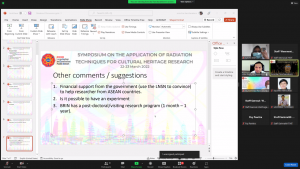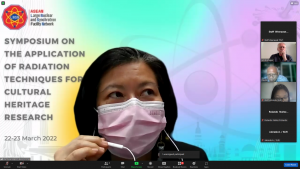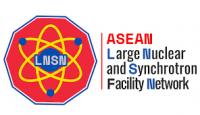
The Symposium on the Application of Radiation Techniques for Cultural Heritage Research was held on during 22-23 March 2022, 1.00-5.00 p.m. (GMT+7) via an online platform.
The purposes of the Research Network on Cultural Heritage establishment include :
- to build a regional research platform applying large-scale facilities located in the ASEAN region such as synchrotron light sources, nuclear research reactors, particle accelerators, as research facilities, in the field of cultural heritage studies,
- to strengthen technical collaboration in the ASEAN region,
- to facilitate access and enhance the utilization of large-scale research facilities among ASEAN researchers, and
- to enhance scientific contribution in the understanding of ASEAN cultural heritage.
- Symposium schedule

| Time | Activity | Speaker |
|
22nd March 2022 |
||
| 12.00 – 13.00 | Registration | |
| 13.00 – 13.10 | Opening remark | |
| 13.10 – 14.00 | A brief introduction to the event | TINT/SLRI + moderator |
| 14.00 – 14.30 | Research in cultural heritage using X-ray techniques | Prof. Koen Janssens,
Department of Chemistry, University of Antwerp, Belgium |
| 14.30 – 15.00 | Utilization of radiation technology in cultural heritage characterization | Dr. Clotilde Boust,
Center for research and conservation for French Museum, France |
| 15.00– 15.30 | Preservation of cultural heritage using irradiation and consolidation technology | Dr. Laurent Cortella,
ARC-Nucléart, France |
| 15.30 – 16.00 | Archaeological research using nuclear research reactor in Malaysia | – Dr. Muhammad Rawi B. Mohamed Zin
– Dr. Hishamuddin HUSAIN Malaysian Nuclear Agency |
| 16.00 – 16.10 | Discussion | Moderator |
| 23rd March 2022 | ||
| 12.00 – 13.00 | Registration | |
| 13.00 – 13.30 | Scientific Archaeology: methods and perspective | Mr.Theerasak Thanusilp
Office of Archaeology, Fine Arts Department, Thailand |
| 13.30 – 14.00 | Archaeological research at ANSTO, Australia | Dr. Floriana Salvemini,
Australian Nuclear Science and Technology Organisation (ANSTO) |
| 14.00 – 14.30 | Archaeological research using nuclear research reactor in Indonesia | Mr. Bharoto BHAROTO
National Nuclear Energy Agency (BATAN) |
| 14.30-15.00 | Preliminary results of analysis of characteristic elements and tracing the origins of ancient ceramics using handheld x-ray fluorescence (XRF) spectrometer | Bui Thi Hong, Faculty of Physics, VNU University of Science |
| 15.00– 16.30
16.30 |
ASEAN Research Network on Cultural Heritage
Closing remark |
Breakout room/Conclusion
|
〉 Speakers list
We thank you from the bottom of my heart for taking time from your busy schedule to be the speakers and all participants at our seminar. Look forward to our next interaction. Wishing you all the best for your future.
- Dr. Floriana Salvemini

Floriana Salvemini is a scientist at the Australian Nuclear Science and Technology Organisation. She is co-responsible for the operation and development of the neutron imaging instrument DINGO, and the co-coordinator of the strategic scientific research project on Cultural Heritage. Her scientific interest includes the investigation of Heritage materials through a non-invasive approach by means of neutron-, synchrotron- and accelerator-based techniques.
.
- Dr. Laurent Cortella

Laurent Cortella worked as a nuclear and material scientist before joining, 20 years ago, ARC-Nucléart, a small grouping of the French Commission for Atomic Energy, the French Ministry of Culture, and the Grenoble city, which is both a laboratory and a cultural heritage preservation workshop. As head of the various facilities of the grouping, including a 60Co gamma irradiator, he has treated thousands of artifacts for insect eradication and/or for disinfection and, if necessary, for consolidation with radio-curable resin by so-called nuclear techniques.
Besides the use of those unconventional techniques for heritage, he has been involved in many issues with organic materials preservation, including archive material, museum or church wooden collections, archaeological waterlogged artifacts, etc., giving him unusual cross-disciplinary expertise. His leitmotiv ii to make those radiation processing available for cultural heritage preservation in a pragmatic way, taking into account the latest developments of research and with respect to the ethical principles in the field. He often advises on conservation treatments in France and abroad and participates in international projects related to the development of radiation techniques for cultural heritage preservation, for instance with IAEA, and is the author and co-author of several scientific publications on those subjects.
.
- Dr. Muhammad Rawi Mohamed Zin

Dr.Muhammad Rawi Mohamed Zin has an undergraduate degree in applied science with majoring in applied physics from the University Science of Malaysia (USM) in 1992. He obtained master degree in material science and engineering in simulating crack growth using his own finite element code applied for fracture mechanics of aluminum materials from the National University of Malaysia in 2001. He has a doctoral degree in physics from Keele University, England in 2010 where works are done on strain-induced crystallization of polymer by utilization simultaneously wide-angle with small-angle x-ray scattering from European synchrotron radiation facility in Grenoble, France. Polymorphism was also studied using a wide-angle neutron diffraction instrument of institute Laue Langevin in Grenoble, France.
Prior to post-academic research, he was involved in the applications of a sealed radioactive source to industries particularly the development of nuclear gauges for oil and gas plant maintenance and troubleshoots. He was lead an international technical cooperation project IAEA on the development of second-generation gamma-ray computed tomography in nuclear Malaysia. He has experience conducting research in the japan atomic energy research institute by utilizing jrr-3m for studying residual stress in silicon carbide composite material. Furthermore, he was chief investigator for the IAEA contract research project on applications of 3d neutron tomography for cultural heritage objects. He experienced as national counterparts for several IAEA expert missions in neutron beam utilization of Triga puspati reactor where the experts including, Pavol Mikula with Jose Sharon from the Rez reactor in Czech republic, Ryula Torok from Budapest neutron center, and Emmanuel Farhi from institute Laue Langevin. He was the chairman of the research reactor advisory safety committee for the Asia Pacific (RASCAP) region from 2013-2014 and was the reactor manager for Triga puspati reactor in 2014-2019. In addition, he involved actively in the education and training of nuclear engineering and neutron beam sciences where he was the course director and pioneered in the establishment of reactor engineering school together with Lubomir Sklenka from the technical University of Prague for Asia pacific region implemented together with Indonesia. Currently, he is the field and industrial advisor for the nuclear engineering school of university technology Malaysia and also responsible for neutron imaging and tomography facility in nuclear Malaysia.
.
- Dr. Hismamuddin

Dr. Hishamuddin graduated from the University Science of Malaysia (USM) in 1998 in materials engineering. His first job was as an engineer in the semiconductor industry until 2002 when his last position was a senior engineer. He joined nuclear Malaysia in 2002 and was attached to the materials technology group under the industrial technology division.
Dr. Hishamuddin obtained his doctoral degree from National University of Malaysia (UKM) (Bangi) in 2014 in materials science specializing himself in the field of metallurgy and corrosion. Throughout his Ph.D. works, he had exposed himself to the field of high-performance intermetallic and passive coatings for corrosion protection. He had supervised at least 15 students (industrial training and final year projects) in this field. He is currently a unit leader for the research and conservation of cultural heritage. His current activities are related to the characterization and preservation of cultural heritage artifacts. Most of his projects are joint projects with the department of museum Malaysia.
In the nuclear field, he has background knowledge in neutron diffraction instrumentation. He has been exposed to the instrumentation and measurement of residual stress using neutron diffraction at the Nuclear Physics Institute (NPI), academy of science Czech Republic (ASCR). In neutron radiography, he is a member in the development of the Neutron Radiography facility and the user of the facility for cultural heritage examination in nuclear Malaysia. He has been exposed in advanced imaging methods using neutrons in Germany and South Korea. In nuclear forensics, he is a secondary chief scientific investigator in developing nuclear forensics analysis laboratory in Malaysia. He is also a qualified internal auditor for ISO9001, ISO17025, and ISO27001.
.

Expertise
-Structural analysis and analysis of mixtures of crystalline compounds by means of milli-beam X-ray powder diffraction (XRPD) in the lab and microscopic XRPD at synchrotron micro/nanoprobe beamlines.
– Microscopic elemental analysis by means of micro-XRF (lateral resolution: ca: 30-40 micrometres in the lab and ca 200 nm at synchrotron nanoprobe beamlines; detection limits for transition elements: in glass-like matrices: ca 50 ppm; at synchrotron facilities: ca 0.5 ppm). – Microscopic major element analysis by means of scanning electron microscopy (lateral resolution: ca 1 micrometer; detection limit: ca 0.1 %). >> source
.
- Mr.Bharoto

Bharoto has developed software for tomographic reconstruction for BATAN Neutron Radiography Facility, as well as data acquisition and control software for most of neutron scattering facilities at Neutron Scattering Laboratory – Serpong, Indonesia.
.
- Dr. Clotilde Boust

Dr. Clotilde Boust is head of the imaging group at Centre de recherche et de restauration des musées de France (C2RMF), the Organization of link between art and science and this is her research& imaging blog.
.
- Theerasak Thanusilp

Theerasak, is an archaeologist from the Office of Archaeology, the official face of the country’s archaeological conservation, Fine Arts Department, Thailand. The duty is to study, survey, and research past human life and culture based on material evidence left from prehistoric to historic periods.
- Bui Thi Hong

Bui Thi Hong is expertise in Reactor physics, Naturally occurring radiative material (NORM) measurement. This is her publication paper from google scholar.
〉 Gallery
















































